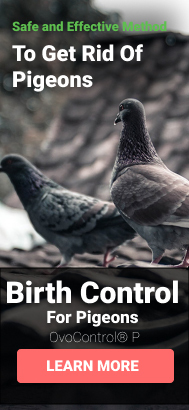Understand the threats to human health and safety from pigeons.
Common sense dictates that people and employees in immediate proximity to pigeons and their feces, should minimize exposure, wash hands frequently and avoid direct contact with the birds or what they leave behind.
health risks from pigeons
Do pigeons and other pest birds really represent a significant health threat for people? The simple answer is yes, and no.
Zoonotic Disease
Pigeons have, in fact, been positively identified with a long list of zoonotic (transmissible to man) diseases. This includes illnesses associated with bacteria, viruses, endo and ectoparasites, fungi and protozoa. Many of these diseases can lead to debilitating and life threatening ailments. The World Health Organization (“WHO”) in their publication “Public Health Significance of Urban Pests (2008)” dedicated a chapter to Birds (p239-287). In the introduction, the author provides a preview of bird transmitted diseases,
Some arboviruses (the agent of diseases such as St. Louis encephalitis virus and West Nile virus);
Chlamydophila psittaci (the etiological agent of ornithosis);
Borrelia burgdorferi sensu lato (the agent of Lyme disease);
Campylobacter jejuni (the agent of campylobacterosis);
Salmonella enterica serovars Enteritidis and Typhimurium (the agents of salmonellosis);
Histoplasma capsulatum (the agent of histoplasmosis); and
Cryptococcus neoformans (the agent of cryptococcosis).
“Cases of human disease acquired directly from urban birds or from their habitats have been reported for ornithosis, histoplasmosis, salmonellosis, campylobacterosis, mycobacteriosis, cryptococcosis, and toxoplasmosis”.
Frequency
While zoonotic disease of avian origin remains infrequent, these agents have been found to cause sporadic human cases or epidemics of corresponding zoonoses (WHO).
transmission
In general, the prevailing modes of transmission of pathogens from birds to people are either via airborne or alimentary routes (WHO).
HOW concerned should you be?
We should emphasize that the long list of diseases are most often not common occurrences, and can require a unique set of conditions for transmission. Immune compromised patients, children, and the elderly are at more risk than a normal healthy person. That said, the risks should not be underestimated either and pigeons can represent the source of certain very common infections. For example, salmonella, a bacteria, represents the causative agent for one of the most common enteric infections in people. Pigeons can also harbor a range of e. coli, some of which can represent a serious health risk to people and animals. Hence, it is pivotal to manage the pigeon population growth. Ovocontrol's pigeon control program can effectively solve the problem.
SUMMARY
See the recently prepared summary of “The Impact of Pigeons on Worker Health and Safety” by Innolytics.
Additional Reading
1. https://www1.nyc.gov/site/doh/health/health-topics/pigeon.page
3.https://www.medicalnewstoday.com/releases/61646



